浸渍相转化法制备陶瓷中空纤维膜的研究进展
综合实验-中空纤维膜的制备
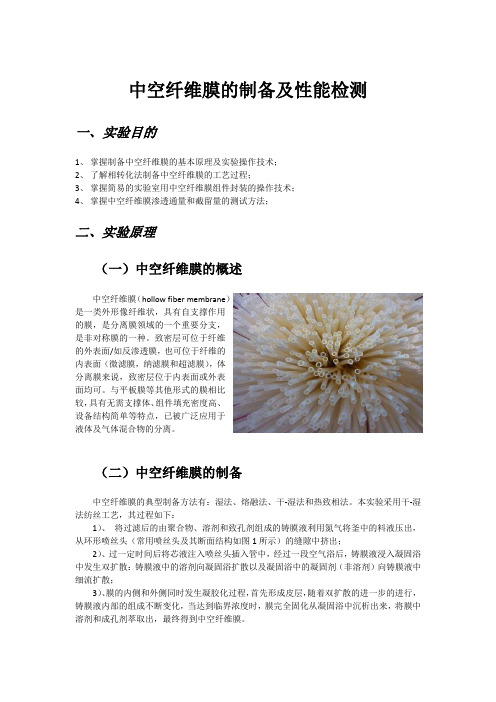
中空纤维膜的制备及性能检测一、实验目的1、掌握制备中空纤维膜的基本原理及实验操作技术;2、了解相转化法制备中空纤维膜的工艺过程;3、掌握简易的实验室用中空纤维膜组件封装的操作技术;4、掌握中空纤维膜渗透通量和截留量的测试方法;二、实验原理(一)中空纤维膜的概述中空纤维膜(hollow fiber membrane)是一类外形像纤维状,具有自支撑作用的膜,是分离膜领域的一个重要分支,是非对称膜的一种。
致密层可位于纤维的外表面/如反渗透膜,也可位于纤维的内表面(微滤膜,纳滤膜和超滤膜),体分离膜来说,致密层位于内表面或外表面均可。
与平板膜等其他形式的膜相比较,具有无需支撑体、组件填充密度高、设备结构简单等特点,已被广泛应用于液体及气体混合物的分离。
(二)中空纤维膜的制备中空纤维膜的典型制备方法有:湿法、熔融法、干-湿法和热致相法。
本实验采用干-湿法纺丝工艺,其过程如下:1)、将过滤后的由聚合物、溶剂和致孔剂组成的铸膜液利用氮气将釜中的料液压出,从环形喷丝头(常用喷丝头及其断面结构如图1所示)的缝隙中挤出;2)、过一定时间后将芯液注入喷丝头插入管中,经过一段空气浴后,铸膜液浸入凝固浴中发生双扩散:铸膜液中的溶剂向凝固浴扩散以及凝固浴中的凝固剂(非溶剂)向铸膜液中细流扩散;3)、膜的内侧和外侧同时发生凝胶化过程,首先形成皮层,随着双扩散的进一步的进行,铸膜液内部的组成不断变化,当达到临界浓度时,膜完全固化从凝固浴中沉析出来,将膜中溶剂和成孔剂萃取出,最终得到中空纤维膜。
图1 喷丝头及其断面示意图膜制备工艺参数对膜结构的影响很大。
主要工艺参数包括:铸膜液的流量、温度、挤出速率、芯液流速、卷绕速度、空气间隙、喷丝头规格等。
(三)中空纤维膜的性能膜的性能包括物理化学性能和分离透过性能。
膜的物理化学性能是指承压性、耐温性、耐酸碱性、抗氧化性、耐生物与化学侵蚀性、机械强度、膜的厚度、含水量、毒性、生物相容性、亲水性和疏水性、孔隙率、电性能、膜的形态结构以及膜的平均孔径等。
中空纤维膜的现状与研究进展

中空纤维膜的现状与研究进展中空纤维膜的现状与研究进展顾蓓蓓,胡啸林(南通大学纺织服装学院,江苏南通 226007)摘要:综述了中空纤维膜的现状和研究进展,包括中空纤维膜的发展历史、中空纤维膜的制备方法、中空纤维膜的工业应用等几个方面,提出了中空纤维膜应用存在的问题,对这个方面所存在的问题和今后发展方向进行了展望,并提出建议。
关键词:中空纤维膜;制备;膜材料;应用Status -quo and R esearch Develop m ent of H oll o w Fiber M e m braneGU B ei -bei ,H U X iao -lin(C ollege o fTex tile and C lothing ,N antong U niversity ,Ji a ngsu Nantong 226007,Ch i n a)Abst ract :The status-quo and research developm ent of hollo w fi b er m e mbrane w ere su mm arized ,i n clud i n g the h i s to r y ,the preparati o n m ethod ,the i n dustria l app lication o f ho ll o w fi b erm e m brane and so on .The proble m s o f ho llo w fi b er m e m brane w ere outli n ed .Based on the pr oble m s ,t h e perspecti v e o f hollo w fi b er m e m brane industr y w as presented,and suggestions w ere pr oposed .K ey w ords :ho llo w fi b er m e mbrane ;preparation ;m e m brane m ateria;l application作者简介:顾蓓蓓(1985-),女,南通大学,在读硕士研究生,主要研究方向:中空纤维膜的应用研究。
PVDF膜的亲水改性研究

PVDF膜的亲水改性研究[摘要]膜技术近几十年飞速发展,但困扰膜使用寿命的一个重要因素就是膜污染。
有效控制膜污染成为现在研究的热点,而改善膜的亲水性是减少膜污染行之有效的方法。
本文通过共混改性的方法,将表面活性剂及聚乙烯吡咯烷酮(PVP)加入到铸膜液中,成功提高聚偏氟乙烯(PVDF)超滤膜的亲水性能。
[关键词]PVDF膜;亲水改性;研究1前言:常用于超滤的膜材料大多是疏水性的,如PVDF等。
它们具有良好的热稳定性及耐化学腐蚀性。
然而疏水性膜的缺点就是在使用过程中易发生溶质吸附和孔堵塞,即膜污染,使得通量下降,使用寿命降低。
膜清洗技术及运行过程中的过程控制对减少膜污染方面有重要作用。
但依旧难以防治聚合物材料本身性质导致污染问题。
因此,要从根本上防治膜污染必须对材料进行改性。
本文采用共混改性的方法,在不降低PVDF超滤膜韧性及机械强度的前提下,加入亲水性成分,以改善PVDF超滤膜的亲水性。
2实验部分:2.1实验材料PVDF为工业品,产自比利时Solvey公司;N,N-二甲基甲酰胺,工业纯,产自巴斯夫;PVP为分析纯,产自广州秦天化工;烷基糖苷APG,工业纯,产自南京卡尼尔。
2.2实验方法将一定比例的PVDF树脂、PVP、APG及致孔剂加入到DMF中,在一定温度下搅拌10小时,静止负压脱泡。
采用浸没沉淀相转化法制备中空纤维膜。
3.结果与讨论3.1水接触角测试结果如图3.1、3.2所示,改性前的PVDF中空纤维超滤膜水接触角比较大,在75°左右,而改性后的PVDF中空纤维超滤膜水接触角明显变小,在15°左右,这表明PVDF中空纤维膜的亲水性得到非常显著的改善。
3.2水处理应用过程水通量监测结果图3.3为改性前后PVDF中空纤维膜在污水处理中的水通量运行图。
从图中可以看到,改性后的中空纤维膜运行水通量绝对值明显高于未改性前的中空纤维膜。
改性后的PVDF膜的普遍临界水通量可达到30-80L/m2h,长期污水运行通量一般为18L/m2h。
PES中空纤维超滤膜的制备及共混改性中期报告
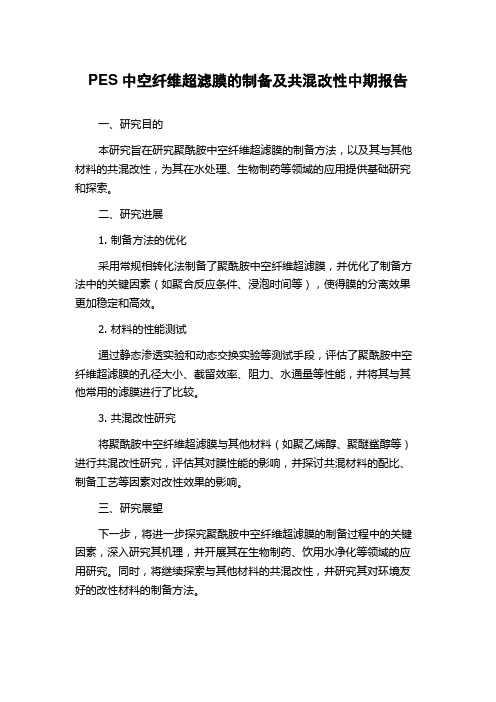
PES中空纤维超滤膜的制备及共混改性中期报告
一、研究目的
本研究旨在研究聚酰胺中空纤维超滤膜的制备方法,以及其与其他材料的共混改性,为其在水处理、生物制药等领域的应用提供基础研究和探索。
二、研究进展
1. 制备方法的优化
采用常规相转化法制备了聚酰胺中空纤维超滤膜,并优化了制备方法中的关键因素(如聚合反应条件、浸泡时间等),使得膜的分离效果更加稳定和高效。
2. 材料的性能测试
通过静态渗透实验和动态交换实验等测试手段,评估了聚酰胺中空纤维超滤膜的孔径大小、截留效率、阻力、水通量等性能,并将其与其他常用的滤膜进行了比较。
3. 共混改性研究
将聚酰胺中空纤维超滤膜与其他材料(如聚乙烯醇、聚醚鲨醇等)进行共混改性研究,评估其对膜性能的影响,并探讨共混材料的配比、制备工艺等因素对改性效果的影响。
三、研究展望
下一步,将进一步探究聚酰胺中空纤维超滤膜的制备过程中的关键因素,深入研究其机理,并开展其在生物制药、饮用水净化等领域的应用研究。
同时,将继续探索与其他材料的共混改性,并研究其对环境友好的改性材料的制备方法。
中空纤维式超滤膜的制备

中空纤维式超滤膜的制备:
超滤膜的制备方法很多,而中空纤维超滤膜主要采用相转换法。
相转换法主要有浸渍凝胶法、溶剂蒸发凝胶法和溶出法等。
目前商品化的中空纤维超滤膜主要采用浸渍凝胶法制备,制膜过程大致可分为七个步骤:
(1)将制膜材料溶入特定的溶剂中,并根据需要加入相应致孔添加剂;(2)通过搅拌使膜材料充分溶解,而成为均匀的制膜液;
(3)过滤去掉未溶解的其他杂质;
(4)脱除溶液中微细的气泡;
(5)在纺丝机中用特制的喷丝头挤出形成中空状原纤;
(6)使原纤中部分溶剂蒸发;
(7)将原纤渍于对膜材料是非溶剂的凝固浴中(通常是水或水溶液),液态原纤立即凝固成固态中空纤维;
(8)后处理使中空纤维具备某种固有性能。
碳化硅陶瓷膜的制备及其应用进展

化工进展Chemical Industry and Engineering Progress2023 年第 42 卷第 12 期碳化硅陶瓷膜的制备及其应用进展李冬燕1,周剑2,江倩2,苗凯3,倪诗莹3,邹栋3(1 南京科技职业学院化学与材料工程学院,江苏 南京 210048;2 南京工业大学化工学院,江苏 南京 211816;3南京工业大学环境科学与工程学院,国家特种分离膜工程技术研究中心,江苏 南京 211816)摘要:碳化硅陶瓷膜具有耐高温、抗热震、耐腐蚀、高通量、使用寿命长等优势,是环境污染治理领域中的关键材料。
如何制备面向应用过程的高性能碳化硅陶瓷膜已经成为目前的研究热点。
本综述介绍了碳化硅陶瓷膜的成膜方法,包括浸渍提拉法、喷涂法、化学气相沉积法及相转化法。
此外,阐明了各方法的成型机理、影响因素及优缺点等,概述了碳化硅膜烧结技术的机理、特点及研究现状,包括重结晶技术、前体转化技术、原位反应烧结技术及新型烧结技术,其中重点描述了共烧技术的实际应用价值及挑战,利于明晰碳化硅陶瓷膜性能与制备工艺的关系。
并阐明了碳化硅陶瓷膜在高温烟气净化、油水分离、气体分离领域中的应用现状及前景,最后对碳化硅陶瓷膜工业化应用潜力作出展望。
关键词:碳化硅陶瓷膜;制备方法;烧结技术;烟气净化;油水分离;气体分离中图分类号:TB34 文献标志码:A 文章编号:1000-6613(2023)12-6399-10Progress in preparations and applications of silicon carbideceramic membranesLI Dongyan 1,ZHOU Jian 2,JIANG Qian 2,MIAO Kai 3,NI Shiying 3,ZOU Dong 3(1 School of Chemical and Materials Engineering, Nanjing Polytechnic Institute, Nanjing 210048, Jiangsu, China; 2College of Chemical Engineering, Nanjing Tech University, Nanjing 211816, Jiangsu, China; 3 National Engineering Research Centerfor Special Separation Membranes, School of Environmental Science and Technology, Nanjing Tech University,Nanjing 211816, Jiangsu, China)Abstract: Silicon carbide ceramic membranes have the advantages of high-temperature resistance, thermal shock resistance, corrosion resistance, high flux, long service life and so on, which are key materials in the field of environmental pollution control. How to prepare high-performance silicon carbide ceramic membranes for application-oriented processes has become a current research hot spot. In this review, the forming methods of silicon carbide ceramic membranes are introduced, including dip-coating method, spraying method, chemical vapor deposition method and phase inversion method. In addition, the molding mechanism, influencing factors, advantages and disadvantages of each method are elucidated.The mechanism, characteristics and research status of silicon carbide membranes sintering technology aresummarized, including recrystallization technology, precursor conversion technology, in-situ reaction综述与专论DOI :10.16085/j.issn.1000-6613.2023-1507收稿日期:2023-08-29;修改稿日期:2023-09-11。
浸入沉淀相转化法制膜
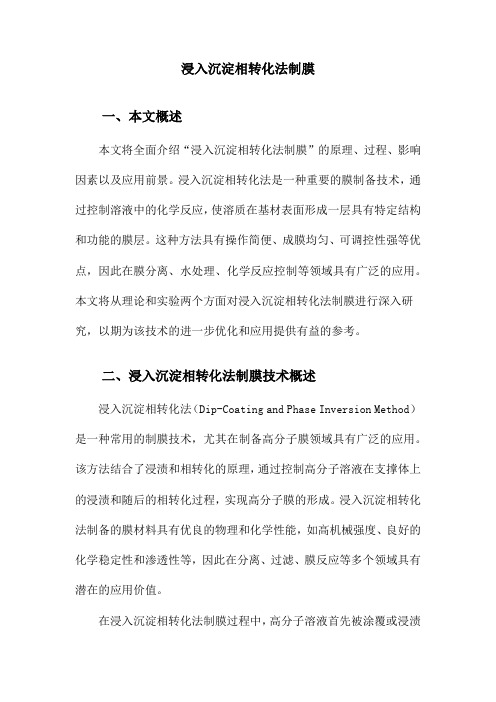
浸入沉淀相转化法制膜一、本文概述本文将全面介绍“浸入沉淀相转化法制膜”的原理、过程、影响因素以及应用前景。
浸入沉淀相转化法是一种重要的膜制备技术,通过控制溶液中的化学反应,使溶质在基材表面形成一层具有特定结构和功能的膜层。
这种方法具有操作简便、成膜均匀、可调控性强等优点,因此在膜分离、水处理、化学反应控制等领域具有广泛的应用。
本文将从理论和实验两个方面对浸入沉淀相转化法制膜进行深入研究,以期为该技术的进一步优化和应用提供有益的参考。
二、浸入沉淀相转化法制膜技术概述浸入沉淀相转化法(Dip-Coating and Phase Inversion Method)是一种常用的制膜技术,尤其在制备高分子膜领域具有广泛的应用。
该方法结合了浸渍和相转化的原理,通过控制高分子溶液在支撑体上的浸渍和随后的相转化过程,实现高分子膜的形成。
浸入沉淀相转化法制备的膜材料具有优良的物理和化学性能,如高机械强度、良好的化学稳定性和渗透性等,因此在分离、过滤、膜反应等多个领域具有潜在的应用价值。
在浸入沉淀相转化法制膜过程中,高分子溶液首先被涂覆或浸渍在支撑体上,然后通过控制温度、溶剂蒸发速率或引入非溶剂等手段,使高分子溶液发生相转化,即从液态转变为固态,从而在支撑体上形成一层连续、均匀的高分子膜。
相转化的过程涉及到高分子链的重新排列和聚集,以及溶剂与非溶剂之间的相互作用,这些因素共同决定了最终形成的膜的结构和性能。
浸入沉淀相转化法制膜的优点在于操作简单、易于控制膜的厚度和结构,并且可以通过调整溶液组成、浸渍条件和相转化参数来调控膜的微观结构和性能。
该方法还适用于制备多层复合膜和功能性膜材料,通过在不同层之间引入不同的高分子或添加剂,可以实现膜材料性能的定制和优化。
然而,浸入沉淀相转化法制膜也存在一些挑战和限制。
例如,在相转化过程中可能会出现膜材料收缩、开裂或缺陷等问题,这些都会影响膜的完整性和性能。
对于某些特定的高分子材料,可能需要特殊的溶剂或非溶剂才能实现有效的相转化,这增加了制膜过程的复杂性和成本。
PEI中空纤维富氮膜的制备及性能研究的开题报告

PPESK/PEI中空纤维富氮膜的制备及性能研究的开题报告题目:PPESK/PEI中空纤维富氮膜的制备及性能研究1.课题背景及研究意义中空纤维膜由于其具有大通量、高分离效率、易于维护等优点,被广泛应用于水处理、膜反应器、气体分离等领域。
近年来,中空纤维膜作为一种富氮材料,也被用于催化、吸附等领域。
然而,普通中空纤维膜的氮含量较低,难以满足某些应用的需求。
因此,制备PPESK/PEI中空纤维富氮膜,具有重要的研究意义和应用价值。
2.研究内容本研究旨在制备PPESK/PEI中空纤维富氮膜,并对其性能进行研究。
具体内容包括:(1)制备PPESK/PEI中空纤维膜:采用浸涂/事前捻合法制备PPESK/PEI中空纤维膜;(2)表征PPESK/PEI中空纤维膜的结构和形貌:利用SEM、FTIR等手段对PPESK/PEI中空纤维膜进行表征;(3)测试PPESK/PEI中空纤维膜的分离性能:采用透过通量、脱盐率等参数评价PPESK/PEI中空纤维膜的分离性能;(4)测试PPESK/PEI中空纤维膜的氮含量:采用元素分析对PPESK/PEI中空纤维膜的氮含量进行测试;(5)测试PPESK/PEI中空纤维膜的吸附性能:采用染料亚甲基蓝作为模型污染物,对PPESK/PEI中空纤维膜的吸附性能进行测试。
3.研究方法(1)聚合物材料的制备采用原位聚合法;(2)制备中空纤维膜采用浸涂法/事前捻合法;(3)利用SEM、FTIR等手段表征PPESK/PEI中空纤维膜的结构和形貌;(4)采用透过通量、脱盐率等参数测试PPESK/PEI中空纤维膜的分离性能;(5)采用元素分析测试PPESK/PEI中空纤维膜的氮含量;(6)采用染料亚甲基蓝作为模型污染物,对PPESK/PEI中空纤维膜的吸附性能进行测试。
4.预期研究成果及意义(1)成功制备出PPESK/PEI中空纤维富氮膜;(2)对PPESK/PEI中空纤维膜进行表征和性能测试,探究膜的结构、形貌、分离性能、氮含量和吸附性能等;(3)预计所制备的膜用于催化、吸附等领域,并可为中空纤维膜的改性提供参考。
聚醚砜中空纤维膜的制备及其性能

聚合 物分 离膜 的结 构 和性能 主要 取决 于成 膜方
聚合 物膜 的形 态结 构和 化学 成分 对膜 的性 能起
着决 定性 的作 用 。聚 醚砜 中空纤 维膜 由于其 良好 的 力 学性 能 、 稳定 性 、 酸 碱 和 抗 细 菌 性 , 热 耐 因而得 到 广泛 应用 。聚醚砜 中空纤 维膜 通常 由浸渍 沉 淀
国药 集 团化学 试 剂 有 限公 司 ; 醚砜 ( E ) 聚 P S ,购 于 上 海 盛宇 贸易 有 限公 司。
露, 真空 镀金 后用 扫 描 电镜 观察 。
14 2 纯 水 通 量 ..
取1 0根 长度 为3 m的 空纤 维 膜 , 中 空 纤 维 0c 将 膜 的两端 并在 一起 , 胶带 固定 , 口用 真空 硅脂 封 用 端 住 , 入模 具 中静 置 若 干 分 钟 。模 具 中倒 入 配好 的 放 P u灌 封胶 ( A组 分 与 B组 分 比例 为 1 1 制 ) 按 :配 , 静 置 固定2 , 多余 的环 氧胶 切 去 , 到与 管 口平 4h 将 直
特 殊 的喷丝 板挤 出 , 生 纤 维 进入 凝 固浴 与 非 溶 剂 初 进 行物 质交 换 , 最后形 成 膜 。
相 转化 法制 备 , 以采 用 许 多 成膜 方 法 来 调 节 膜 结 可
构, 本文 选用 浸 渍 沉 淀相 转 化 法 。通 过 改 变 聚 醚 砜 溶 液浓 度 、 空气 浴 时 问和 凝 固浴 温度 等来 控 制 膜 的
・ 1・ 2
后, 用刀 片 沿纤维 长 度方 向斜 切 , 内外 表 面 同时暴 使
1 实 验 部 分
1 1 材 料 . N, - 甲基 乙酰 胺 ( M c 、 乙 烯 吡 咯 烷 酮 N二 D A )聚 k0 P P k 0 、 乙 烯 吡 咯 烷 酮 k 0 ( V —3 、 9 ( V —9 ) 聚 3 P P k0) 正丁 醇 、 乙二 醇 4 0 丙 三 醇 ,皆为 分 析 纯 ,购 于 聚 0、
PVB在分离膜材料领域的应用研究进展
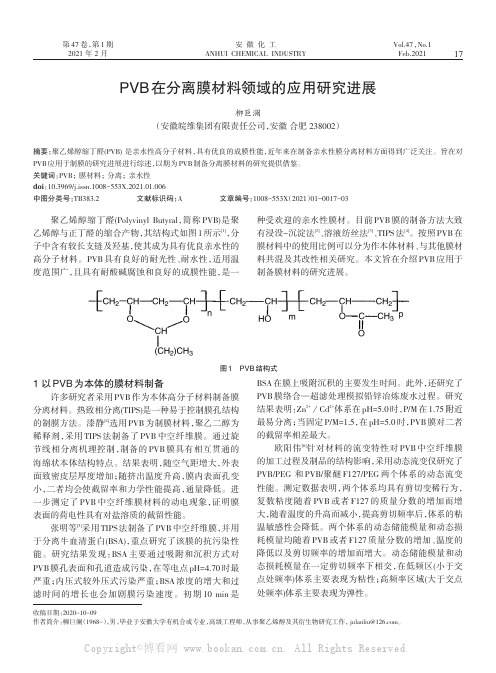
PVB 在分离膜材料领域的应用研究进展柳巨澜(安徽皖维集团有限责任公司,安徽合肥238002)摘要:聚乙烯醇缩丁醛(PVB)是亲水性高分子材料,具有优良的成膜性能,近年来在制备亲水性膜分离材料方面得到广泛关注。
旨在对PVB 应用于制膜的研究进展进行综述,以期为PVB 制备分离膜材料的研究提供借鉴。
关键词:PVB ;膜材料;分离;亲水性doi :10.3969/j.issn.1008-553X.2021.01.006中图分类号:TB383.2文献标识码:A文章编号:1008-553X (2021)01-0017-03收稿日期:2020-10-09作者简介:柳巨澜(1968-),男,毕业于安徽大学有机合成专业,高级工程师,从事聚乙烯醇及其衍生物研究工作,julanliu@ 。
聚乙烯醇缩丁醛(Polyvinyl Butyral ,简称PVB)是聚乙烯醇与正丁醛的缩合产物,其结构式如图1所示[1],分子中含有较长支链及羟基,使其成为具有优良亲水性的高分子材料。
PVB 具有良好的耐光性、耐水性,适用温度范围广,且具有耐酸碱腐蚀和良好的成膜性能,是一种受欢迎的亲水性膜材。
目前PVB 膜的制备方法大致有浸没-沉淀法[2]、溶液纺丝法[3]、TIPS 法[4]。
按照PVB 在膜材料中的使用比例可以分为作本体材料、与其他膜材料共混及其改性相关研究。
本文旨在介绍PVB 应用于制备膜材料的研究进展。
图1PVB 结构式1以PVB 为本体的膜材料制备许多研究者采用PVB 作为本体高分子材料制备膜分离材料。
热致相分离(TIPS)是一种易于控制膜孔结构的制膜方法。
漆静[4]选用PVB 为制膜材料,聚乙二醇为稀释剂,采用TIPS 法制备了PVB 中空纤维膜。
通过旋节线相分离机理控制,制备的PVB 膜具有相互贯通的海绵状本体结构特点。
结果表明,随空气距增大,外表面致密皮层厚度增加;随挤出温度升高,膜内表面孔变小,二者均会使截留率和力学性能提高,通量降低。
新型中空纤维陶瓷膜的制备方法
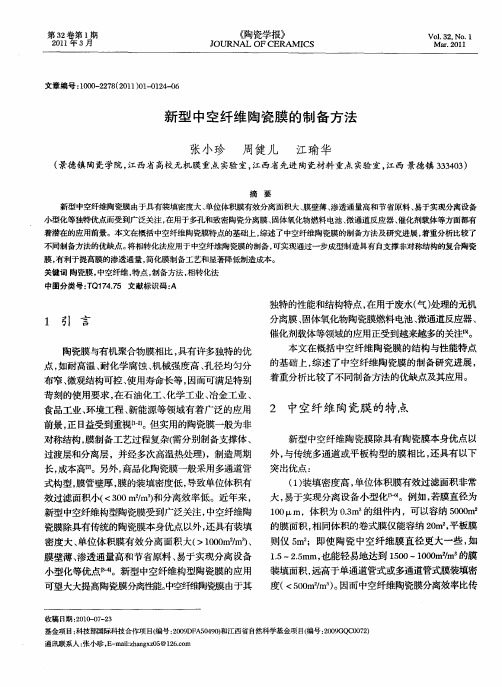
2 中空纤维 陶瓷膜 的特 点
新型 中空纤维陶瓷膜 除具有陶瓷膜本身优点以 外, 与传统多通道或平板构型的膜相比, 还具有以下
突 出优 点 :
长, 成本高圆 。另外 , 商品化陶瓷膜—般采用多通道管
新 型 中空纤维 陶瓷膜 的制备 方法
张小珍 周健儿 江瑜华
( 景德镇 陶瓷学 院, 江西省 高校 无机膜 重点 实验 室 , 江西省 先进 陶瓷材料 重 点 实验 室 , 江西 景德镇 330 ) 343
摘 要
新型 中空纤维陶 瓷膜 由于具 有装填密度大 、 单位体积膜有效分离面积大 、 膜壁薄 、 渗透通量高和节省原料、 易于实现分离设备 小型化等独特优点而受到广泛关注 , 用于多孔和 致密 陶瓷分离膜 、 在 固体氧化物燃料电池 、 微通道反应器 、 催化 剂载体等方面都有 着潜在 的应用前景 。本文在概括 中空纤维陶瓷膜特点的基础上 , 综述 了中空纤维陶瓷膜的制备方法 及研 究进展 , 着重分析比较 了 不 同制备方法的优缺点。 将相转化法应用于中空纤维陶瓷膜的制备 , 可实现 通过一步成型制造具 有自支撑非对称结构的复合陶瓷 膜, 有利于提高膜的渗透通量 , 简化膜制备工艺和显著降低制造成本。 关键词 陶瓷膜 , 中空纤维 , 特点 , 制备方法 , 相转化 法
本文在概括中空纤维陶瓷膜的结构与性能特点 的基础 上, 综述了中空纤维陶瓷膜的制备研究进展 , 着重分析比较了不 同制备方法的优缺点及其应用。
点, 如耐高温 、 耐化学腐蚀 、 机械强度高 、 孔径均匀分 布窄 、 微观结构可控 、 使用寿命长等 , 因而可满足特别 苛刻的使用要求 , 在石油化工 、 化学工业 、 冶金工业 、 食品工业 、 环境工程、 新能源等领域有着广泛的应用 前景 , 日 正 益受到重视【 但实用的陶瓷膜一般为非 l。 ’ 2
高渗透性YSZ中空纤维陶瓷微滤膜的制备

采用 8 o%氧化钇 稳 定氧化 锆 (Y Z 陶瓷微 m1 8 S)
《 陶瓷学报) o o年第 3 ) l 2 期
图 1 实验 所 用 8 S Y Z粉体 的粒 径 分 布
Fi. r ce sz s r u i n o x e i n a g 1 Pa t l ie dit b t fe p r i i o me t
图 2 干 , 法 纺 丝 过程 示意 图 湿
Fi. h m ai ig a o r/ t pn ig po e s g2 Sc e t da r m f ywe inn rc s c d s
8 YSZ p wd r o e
一 u 鲁 【0 I § U 0 口0 l u 1 1
其 原因在于需采用粒径大于 1 pm 的 Y Z粉制备 0, S
环境工程、新 能 源等领 域有 着广 泛的应用前景 , 因 而日 益受到重视【】 但实用的陶瓷膜为非对称结构 , l。 _ 2 膜制备工艺过 程 复 杂 ( 分 别制 备 支撑体 、 需 过渡层 和分离层 , 并经多次高温热处理)制造周期长 , , 成本 型 ,膜的装填密度低,单位体积有效过滤面积小( < 30 0 m , 分离效率低。近年来 , 新型 中空纤维构型
丝一步成型和一次高温烧成制备了非对称 Y Z中空 S
纤维陶瓷微滤膜 , 并对制备的膜进行了微观结构与渗
透 I能表征 。 生
化法在中空纤维陶瓷膜制备中的应用, 还可实现通 2 实 验
过一步成型制造非对称结构的陶瓷膜 , 从而可望大大 提高膜分离性能 、 简化膜制备工艺和显著降低制造成 21 Y Z中空纤维膜制备 . S
粉 制备 Y Z中空纤维 陶瓷膜 ,其粒径主要 分布在 S
07一1 m,5=08 m( 图 1 。采 用工 业 级 聚 . . 5 d0 . O 见 )
浸没沉淀法制备PVDF微孔膜
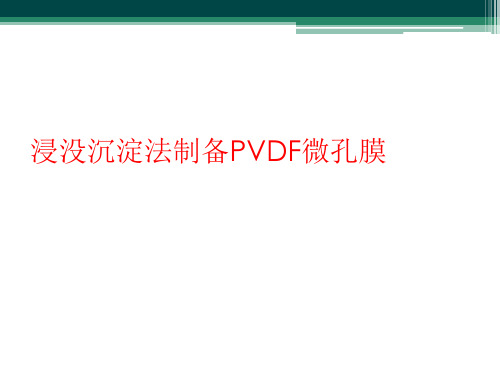
3、聚合物的浓度、溶剂/非溶剂体系的选择、制ቤተ መጻሕፍቲ ባይዱ液组成、凝胶浴的组成等对 膜的结构形态和性能影响较大;
极性由大到小: DMF > 二噁烷> 丙酮> THF
添加剂对膜结构和性能的影响
通过调整聚合物溶液中添加剂的种类和比例可以影响溶液中胶束聚集态 和网络状态的比例及尺寸、混合溶剂的溶度参数和化学位以及凝胶过程中 水与混合溶剂的交换扩散速率, 最终影响膜成型后的孔径大小、分布及孔 隙率
含大分子致孔剂PVDF中空纤维膜貌
孔膜,在不同聚合物浓度下均发生瞬时液-液分相, 但是对高浓度的聚合物
聚 合
制膜液,薄膜/凝固浴界面处的聚合物浓度较高,因而将形成孔隙率较低的多 孔表层,所形成膜的水通量亦较小。
物
浓
度
的
影
响
PVDF浓度对膜性能的影响
溶剂/非溶剂体系
当铸膜液中溶剂向外扩散传质的速度大于非溶剂向内传质的速度时, 有利于形成表皮致密膜;而当非溶剂向内扩散传质的速度大于溶剂向外传质 的速度时, 易形成多孔膜。
加入不良溶剂对膜结构的影响
凝固浴组成对膜结构和性能的影响
非溶剂与溶剂之间的相互作用影响膜的结构和性能。二者相互作用越 大, 也就是二者溶度参数差值越小, 聚合物凝胶速率越快, 从而产生较大 的指状孔,而较慢的凝胶速率产生海绵状孔。
结论
1、浸没沉淀相转化法制膜过程中, 聚合物的相转变(如凝胶化、玻璃化转变或结 晶)可有效固定由液-液分相过程所形成的结构形态, 并最终形成不同结构形态的聚合 物分离膜;
添加剂
中空纤维膜制备
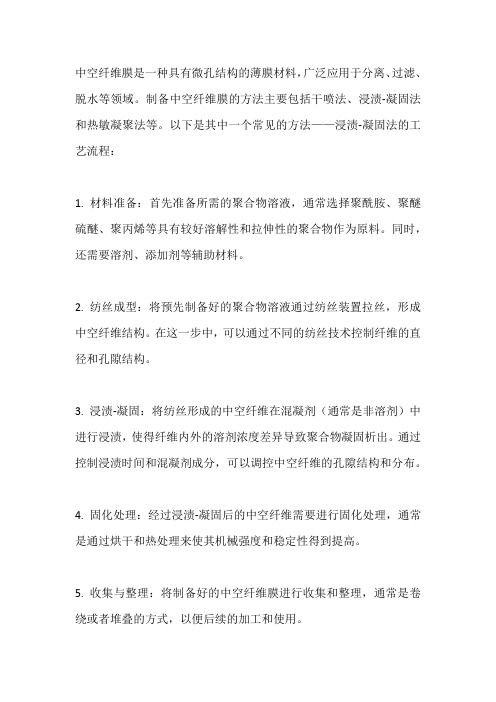
中空纤维膜是一种具有微孔结构的薄膜材料,广泛应用于分离、过滤、脱水等领域。
制备中空纤维膜的方法主要包括干喷法、浸渍-凝固法和热敏凝聚法等。
以下是其中一个常见的方法——浸渍-凝固法的工艺流程:
1. 材料准备:首先准备所需的聚合物溶液,通常选择聚酰胺、聚醚硫醚、聚丙烯等具有较好溶解性和拉伸性的聚合物作为原料。
同时,还需要溶剂、添加剂等辅助材料。
2. 纺丝成型:将预先制备好的聚合物溶液通过纺丝装置拉丝,形成中空纤维结构。
在这一步中,可以通过不同的纺丝技术控制纤维的直径和孔隙结构。
3. 浸渍-凝固:将纺丝形成的中空纤维在混凝剂(通常是非溶剂)中进行浸渍,使得纤维内外的溶剂浓度差异导致聚合物凝固析出。
通过控制浸渍时间和混凝剂成分,可以调控中空纤维的孔隙结构和分布。
4. 固化处理:经过浸渍-凝固后的中空纤维需要进行固化处理,通常是通过烘干和热处理来使其机械强度和稳定性得到提高。
5. 收集与整理:将制备好的中空纤维膜进行收集和整理,通常是卷绕或者堆叠的方式,以便后续的加工和使用。
需要注意的是,在整个制备过程中,需要控制好各个环节的工艺参数,如纺丝速度、浸渍时间、固化温度等,以确保最终获得具有理想性能的中空纤维膜产品。
总的来说,浸渍-凝固法制备中空纤维膜工艺流程相对简单,操作容易掌握,适用于一些常见的聚合物材料,因此在实际生产中得到了广泛应用。
国内中空纤维陶瓷膜的制备研究及应用概况
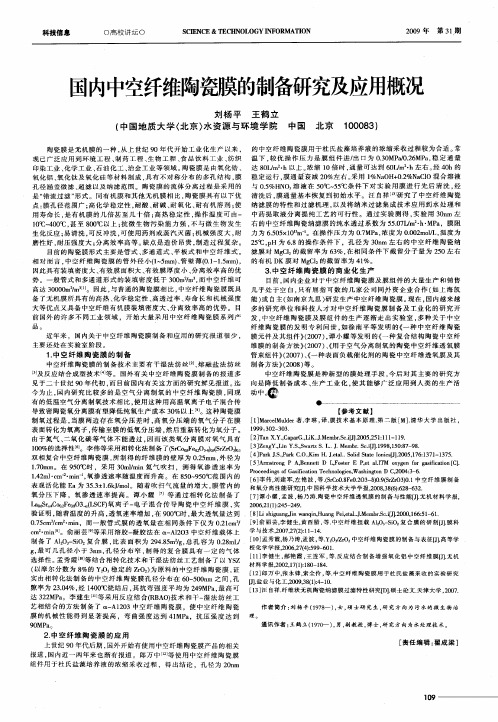
0高校讲坛 0
S I N E&T C N O YI OR CE C E H OL G NF MATON I
20 0ቤተ መጻሕፍቲ ባይዱ9年
第3 l期
国内中空纤维陶瓷膜的制备研究及应用概况
刘 杨 平 王 鹤 立 ( 国地质 大学 ( 京> 资源 与环 境 学院 中国 中 北 水
北京
10 8 0 0 3)
相 对而言 , 中空 纤 维 陶 瓷 膜 的管 外 径 小 (~ rm)管壁 薄 (.—1 m , 的 有 机 D 15 a 、 O1 . m) 5 K膜 对 M l的 截 留 率 为 4 % 。 l
因此 具 有 装 填 密 度 大 、 效 膜 面 积 大 、 效 膜厚 度 小 、 离 效 率 高 的优 有 有 分 3 中空 纤 维 陶 瓷 膜 的 商 业 化 生产 . 势 。一 般 管 式 和 多 通 道 形 式 的 装 填 密 度 低 于 3 0 / 而 中空 纤 维 可 0 m2 , m 目前 , 内 企业 对 于 中 空纤 维 陶 瓷膜 及 膜 组 件 的 大 量 生 产 和 销 售 国 高 达 3 0 0 2 。因 此 , 普 通 的 陶 瓷膜 相 比 , 空纤 维 陶瓷 膜 既 具 几 乎处于空 白, 0 0 m/ m 与 中 只有 屈指可数 的几 家公司 同外 资企业合作 ( 上海凯 如 备 了无 机 膜 所 具 有 的 高 热 、 学 稳定 性 、 透过 率 、 命 长 和 机 械 强 度 能 ) 自主 ( 化 高 寿 或 如南 京 九思 ) 发 生 产 中空 纤 维 陶瓷 膜 。 在 , 内越 来 越 研 现 国 大 等 优 点 又 具 备 中 空 纤 维 有 机膜 装 填密 度 大 、 离 效 率 高 的 优 势 。 目 分 多 的 研 究 单 位 和 科 技 人 才 对 中 空纤 维 陶 瓷 膜 制 备 及 工 业 化 的研 究 开 前 国外 的许 多 不 同 工 业 领 域 ,开 始 大 量 采 用 中 空 纤 维 陶瓷 膜 系 列 产 发 , 空 纤 维 陶 瓷 膜 及 膜 组 件 的生 产 逐 渐 走 出 实 验 室 , 种 关 于 中 空 中 多 纤 维 陶 瓷 膜 的 发 明专 利 问 世 , 徐 南 平 等 发 明 的 《 种 中空 纤 维 陶 瓷 如 一 近 年 来 ,国 内关 于 中 空纤 维 陶瓷 膜 制 备 和 应 用 的研 究 报 道 很 少 , 膜 元 件 及 其 组 件 》 2 0 )谭 小 耀 等 发 明 的《 种 复 合 结 构 陶 瓷 中 空 纤 (0 7 , 一 主 要 还 处 在 实 验 室 阶段 。 维 膜 的制 备 方 法 ) 2 0 )《 于 空 气 分 离 制 氧 的 陶瓷 中空 纤 维 透 氧 膜 ) 0 7 、用 ( 管 束 组 件 》 2 0 )《 种 表 面 负 载 催 化 剂 的 陶瓷 中空 纤 维 透 氧膜 及 其 (0 7 、一 中空 纤 维 陶 瓷 膜 的 制 备 技 术 主要 有 干 湿 法 纺 丝 、 融 盐 法 纺 丝 制 备 方 法 ) 2 o ) 。 】熔 (o 8 等 吸 反 应 结合 成 型技 术 等 。 国外 有 关 中空 纤 维 陶瓷 膜 制 备 的 报 道 多 中空 纤 维 陶 瓷 膜 是 种 新 型 的 膜 处 理 手 段 , 后 对 其 主要 的研 究方 今 见于二十世纪 9 0年 代 初 , 目前 国 内有 关 这 方 面 的研 究 鲜见 报 道 。 而 迄 向是 降低 制 备成 本 、 产 工 业 化 , 其 能 够 广 泛 应 用 到 人 类 的 生 产 活 生 使 今 为 止 , 内研 究 比较 多 的 是 空 气 分 离 制 氧 的 中空 纤 维 陶 瓷 膜 , 现 动 中 。 国 同
新型陶瓷纤维的制备及性能研究现状及发展趋势

新型陶瓷纤维的制备及性能研究现状及发展趋势∗高伟超;康永【摘要】Ceramic fiber is a set of traditional insulation materials,refractory fibrous excellent perform-ance in one light-weight refractories,ceramic fiber,light weight,high temperature,thermal stability,low ther-mal conductivity,heat re-sistance of small and advantages such as mechanical vibrations,which involves all areas of its products,development pros-pects.This paper points out the present situation of the preparation and properties of the new ceramic fiber,and points out the development direction of the ceramic fiber technology in the future.%陶瓷纤维是一种集传统绝热材料、耐火材料优良性能于一体的纤维状轻质耐火材料。
它具有质量轻、耐高温、热稳定性好、导热率低、比热小及耐机械震动等优点,因而其产品涉及众多领域,发展前景十分看好。
笔者叙述了新型陶瓷纤维的制备、性能研究现状及未来陶瓷纤维技术发展方向。
【期刊名称】《陶瓷》【年(卷),期】2016(000)010【总页数】4页(P21-24)【关键词】陶瓷纤维;制备;性能;研究趋势【作者】高伟超;康永【作者单位】陕西金泰氯碱化工有限公司陕西榆林 718100;陕西金泰氯碱化工有限公司陕西榆林 718100【正文语种】中文【中图分类】TQ174.75陶瓷纤维是一种纤维状轻质耐火材料,具有质量轻、耐高温、热稳定性好、导热率低、比热容小及耐机械振动等优点,因而在机械、冶金、化工、石油、交通运输、船舶、电子及轻工业部门都得到了广泛的应用,在航空航天和其它要求耐高温和较好力学性能的部件,包括烧蚀材料(如宇航器重返大气层的隔热罩、火箭头锥体、喷嘴、排气口和隔板等)[1]。
- 1、下载文档前请自行甄别文档内容的完整性,平台不提供额外的编辑、内容补充、找答案等附加服务。
- 2、"仅部分预览"的文档,不可在线预览部分如存在完整性等问题,可反馈申请退款(可完整预览的文档不适用该条件!)。
- 3、如文档侵犯您的权益,请联系客服反馈,我们会尽快为您处理(人工客服工作时间:9:00-18:30)。
浸渍相转化法制备陶瓷中空纤维膜的研究进展刘朋超;马敬红;杨曙光;龚静华;徐坚【摘要】浸渍相转化法可以制备非对称结构的陶瓷中空纤维膜.本文讨论了陶瓷中空纤维膜的发展情况,并着重探讨了各因素对膜孔结构的影响.大量陶瓷粉体存在情况下的相转化机理,孔结构与力学强度的平衡问题,是目前需要重点关注的两个问题.有效调节孔结构,保证其力学性能可以实现陶瓷中空纤维膜在分离和纯化、固体氧化物燃料电池、膜催化器和膜反应器等方面的广泛应用.%Ceramic hollow fiber membranes (CHFM) with an asymmetric structure can be fabricated by the method nonsolvent induced phase separation (NIPS). The paper reviews the progress and tendency of the ceramic hollow fiber membranes using NIPS technic, especially on the influence of factors on the structure of hollow membranes. The discussion on the mechanism of phase inversion in the systems containing much ceramic powders, with the balance between porous structure and mechanical strength, are two important issues of requiring concern. Through structure's controlled effectively and mechanical strength preserved, hollow fiber membranes can be widely applied in the fields of separation and purification, solid oxide fuel cell (SOFC), membrane contactors and reactors.【期刊名称】《无机材料学报》【年(卷),期】2012(027)007【总页数】7页(P673-679)【关键词】浸渍相转化法;陶瓷;中空纤维膜;综述【作者】刘朋超;马敬红;杨曙光;龚静华;徐坚【作者单位】东华大学材料科学与工程学院,纤维材料改性国家重点实验室,上海201620;东华大学材料科学与工程学院,纤维材料改性国家重点实验室,上海201620;东华大学材料科学与工程学院,纤维材料改性国家重点实验室,上海201620;东华大学材料科学与工程学院,纤维材料改性国家重点实验室,上海201620;东华大学材料科学与工程学院,纤维材料改性国家重点实验室,上海201620【正文语种】中文【中图分类】TQ028Abstract: Ceramic hollow fiber membranes (CHFM) with an asymmetric structure can be fabricated by the method nonsolvent induced phase separation (NIPS).The paper reviews the progress and tendency of the ceramic hollow fiber membranes using NIPS technic,especially on the influence of factors on the structure of hollow membranes.The discussion on the mechanism of phase inversion in the systems containing much ceramic powders,with the balance between porous structure and mechanical strength,are two important issues of requiringconcern.Through structure’s controlled effectively and mechanical strength preserved,hollow fiber membranes can be widely applied in the fields of separation and purification,solid oxide fuel cell (SOFC),membrane contactors and reactors.Key words: nonsolvent induced phase separation; ceramic; hollow fiber membranes; review能源紧张、资源短缺、生态环境恶化等诸多问题已经成为全世界人类共同面临的问题.膜分离作为一种高效率、节能和环境友好的技术,在能源与化工、水资源再生利用、环境保护等领域发挥着越来越重要的作用,是未来几十年最有发展前途的高新技术之一[1].在过去的几十年里,膜分离技术已经成功用于各种分离过程.由于具有高的比表面积和选择透过性,不同种类的聚合物中空纤维膜已经大量的生产和广泛的应用[2].然而,有机聚合物膜由于具有较弱的热、化学稳定性以及易被污染的缺点,只适用于温和的操作环境.而由多孔玻璃,陶瓷材料(如氧化铝(Al2O3)、氮化硅(Si3N4)、碳化硅(SiC)),金属氧化物或者是合金制备的无机膜具有相对较高的耐磨性,耐化学和耐热降解性,因此更适用于腐蚀和高温等苛刻的操作环境.陶瓷膜与聚合物膜一样,其样式一般有板式、管式、多通道式,比表面积较低,约为30~250 m2/m3[3-4],蜂巢式多通道式比表面积可达800 m2/m3[5].催化膜反应器对比表面积的要求尤为重要,因为它需要高的比表面积和堆积密度才能增加目的产物的透过速率和催化效率[6].管式膜形式又包括中空纤维膜(直径<0.5 mm),毛细管式(0.5 mm<直径<5 mm)和管式膜(直径>5 mm)[7].三者的区别在于: 管式膜一般直径比较大,必须有支撑层,而中空纤维式和毛细管式为自支撑膜.陶瓷中空纤维膜的制备方法包括模板法[8-13]、静电纺丝法[14-17]、挤压成型法和相转化法等.相转化制膜法根据改变状态的物理方法的不同,可以分为: 溶剂蒸发相转化法[18-19]、吸入蒸气相转化法、控制蒸发相转化法、热致相转化法[20-21]和浸渍相转化法等[22-24].在以上几种相转化法中,浸渍引发相转化法制备工艺简单,且具有更多的工艺可变性,能够根据膜的应用更好地调节膜的结构和性能.相转化法膜制备工艺始于上世纪60年代,Loeb和其合作者首次采用相转化方法制备了非对称结构的反渗透膜,从而使聚合物分离膜有了工业应用的价值[25].采用相转化方法制备氧化铝中空纤维膜的报道最早见于20世纪90年代初,Lee和Kim[26]在湿法纺丝的基础上,采用相转化法制备了具有非对称结构的Al2O3中空纤维膜.目前,对于有机和无机中空纤维膜研究最多的为Li等,他们所采用的方法为浸渍相转化法,采用设备为干湿法纺丝设备如图1[27]所示,关键部件为带有内插管的喷丝组件,插管内部是具有稳定流速的内凝固浴,相转化开始于从喷死组件挤出的那一刻; 在经过一段空气间距后,进入外凝固浴,最后完成卷绕.在不存在陶瓷粒子的聚合物体系中至少包含三种物质,即聚合物、溶剂和非溶剂,成膜过程分为分相过程和相转化过程[28].其中分相过程是决定膜孔结构的关键步骤,研究内容包括制膜体系的热力学性质以及传质动力学.在早期研究中,Strathmann 等利用三元相图来直观表征铸膜液的热力学性质,认为分相机制包括瞬时分相和延时分相两种机理[29-30].瞬时分相时间t<1 s,组分变化经过双节线,意味着浸入凝固浴后液液分相立即发生; 如果浸入凝固浴后体系仍然为混溶单相,则意味着分相没有立即发生,即为延时分相.在经历较长时间后,组分跨过双节线,分相也会发生.两种不同的分相过程将会导致膜形态完全不同[31],延时分相会使膜具有“海绵状”的孔形态,瞬时分相则会使膜具有“指状”孔结构.对于NIPS的动力学描述,Cohen等对于相转化过程的早期阶段提出了多孔膜形成的扩散控制的传质模型[32].假设溶剂与非溶剂的扩散系数是相等的,那么溶剂与非溶剂的扩散过程可以看作是一维扩散过程,当相分离发生时,由两种相互分散的平衡相所组成的三维结构就会形成,并且这种两相结构会扩散到双节线下的所有组分.利用这种扩散模型,他们确定溶剂与非溶剂的交换可以导致聚合物溶液中的不稳定组成成分变化.在Cohen的工作之后,Reuvers、Tsay[33]、Radovanovic[23]等预测了沉淀路径.其中Radovanovic建立的模型经常用来描述发生在浸渍阶段的传质过程.扩散模型解释了相分离过程中两种分相模式的发生,用来预测浇铸膜的早期组分的范围.在采用NIPS方法制备氧化铝中空纤维膜的体系中,以聚醚砜(PESf)高分子助剂为例,Al2O3所占的比例很大,它们之间的质量比从1/3~1/9.大量Al2O3粉体的存在势必会对NIPS的机理有很大影响,但是目前对于此方面报道很少.不过对于混合基体膜中大孔的形成机理却有少量研究报道,分散相(无机粉体)和连续相之间界面的稳定性是由分散相(无机粉体)和它与连续相组分(聚合物、溶剂与非溶剂)之间的表面能所决定的.如果无机粉体与溶剂的相互作用很强,那么无机粉体就会起到大孔成核剂的作用.然而,当无机粒子的浓度处于某个临界浓度时,其它核的快速生成于已成核的前沿,就会阻止已成核继续扩张形成大孔,多核的生成就会抑制大孔的形成.Wara 等[34]观察到了亚微米氧化铝大量的加入会降低聚合物相的扩散速率,从而抑制大孔结构的发生.分相速率决定了最终生成的是大孔还是小孔,相分离的不均一性导致大孔结构的生成.Li等[35]认为对于含有陶瓷粒子的聚合物分散体系来说,当陶瓷粒子被聚合物包覆良好时,这些粒子可以看作是聚合物的结点(nodules),在相转化溶剂与非溶剂交换时,不同大小的粒子迁移速率是不同的,小粒子迁移到界面的速率快于大的粒子,从而生成层级梯度结构.通过控制小粒子与大粒子的比率和溶剂与非溶剂的交换速率可以控制膜的结构.陶瓷中空纤维膜的基本孔结构包括“海绵状”孔结构与“指状”孔结构.如前所述,瞬时分相生成指状孔结构,延时分相则生成海绵孔结构.也就是说,任何对分相机制有影响的因素都会影响最终孔结构.这些因素包括掺杂组分和相对浓度、纺丝温度、溶液挤出速率、空气间距、拉伸比、内部非溶剂组分、外凝固浴组分和温度等等,往往这许多复杂的因素有很强的相互依赖性,从而导致对结构的控制是非常复杂的. 采用相转化方法制备含有陶瓷粒子和聚合物的中空纤维膜前驱体,通过烧结除去有机物,最终得到陶瓷中空纤维膜.陶瓷粒子在体系中所占比重与粒径的大小决定了膜的孔径和表面孔隙度.随着Al2O3/PESf的增大(<9),膜的孔径与表面孔隙度下降[2],这就意味着为了制备致密膜,Al2O3的含量应该越大越好.小粒径的Al2O3有利于制备比较小的孔和无裂纹膜[36],但是在实验中发现即使在Al2O3/PESf比较小的时候,粒径为0.01 μm的Al2O3仍很难制备中空纤维膜,原因在于小粒径的陶瓷粒子具有的大比表面积特性导致铸膜液体系的流动性降低.对于NIPS方法,聚合物的选择是非常重要的,因为它限制了在相分离过程中溶剂与非溶剂的选择.此外对于制备氧化铝中空纤维膜,聚合物在后期的烧结过程中会被烧结掉,这就要求聚合物的热降解温度足够高从而起到一定支撑作用,否则会引起陶瓷粒子的坍塌.目前应用最广的高分子助剂为PESf[37].它的溶剂一般为N-甲基吡咯烷酮(NMP)、N,N-二甲基乙酰胺(DMAc)和N,N-二甲基甲酰胺(DMF).溶剂与非溶剂的选择会影响到膜的形态、力学性能、界面特征和分离性能.聚合物必须能够溶解或者是容易分散到溶剂中,并且溶剂与非溶剂必须能够混溶.溶剂与非溶剂的混溶性越大,越容易发生瞬时分相制备多孔膜.至于混溶性比较差的情况,所制备的膜一般为具有致密无孔顶层的非对称膜.水是最常用的非溶剂,丙酮、低脂肪族醇也可以作为非溶剂.如果非溶剂中加入一定溶剂,则有可能抑制瞬时分相的发生,分相的延迟会导致无孔膜结构的生成.如果内外非溶剂均为水,则生成的中空纤维膜内外层均为指状孔结构,如图2(a)[38],如果内部非溶剂为50wt% NMP的水溶液,外部非溶剂为水,则制备的中空纤维膜结构如图2(b)[39];如果内部非溶剂是水,外部非溶剂是乙醇水溶液,由于溶剂与两种非溶剂扩散速率的差异,生成了指状孔结构在内侧,而外侧是致密结构的中空纤维膜,如图2(c)[40].采用干湿相转化法制备中空纤维膜时,空气间距的存在对膜形态结构的影响非常大.当铸膜液从含有内插管的喷丝板挤出时,中空纤维膜的内层接触到内凝固浴,开始溶剂与非溶剂双扩散的相转化过程; 而在中空纤维膜的外层接触到的是空气,易挥发的溶剂开始挥发,同时吸附空气中的潮气,外层进行相转化过程,内外层相转化的不同步性和程度的差异,造成了内外结构的差异.Li等[38]研究不同的空气间距对膜结构的影响,研究发现随着空气间距的变大,内部指状孔结构区域变大,外部指状孔结构变小直至消失,如图3所示.同时,研究还发现在内部非溶剂(水)的挤出速率与体系的粘度(通过体系中添加不同含量得水进行调节)保持一个定值的时候,随着水的挤出速率的增大,指状孔结构减少.烧结温度、烧结速率和烧结时间等烧结条件会影响最终得到的中空纤维膜的微观结构: 表面形态,晶粒生长和孔的演化或消除.烧结的过程一般由程序控制升温实现,如图4[41]所示.由于致密化、晶粒粗化和孔的关闭等原因,粒子的移动在每个阶段表现出不同的特征.高温会使体系中的聚合物分解,从而引起体积的收缩.随着烧结温度的升高,最大孔径(缺陷孔)下降,但是平均孔径基本不受影响[2].高温对于Al2O3粒子之间的成键熔融是很重要的,若想获得力学强度良好的Al2O3中空纤维膜,烧结温度不能低于1500℃.高温烧结还会引起晶粒的生长,这有利于膜表面的光滑与致密化.陶瓷中空纤维膜弥补了有机中空纤维膜的不足,拓宽了其应用的范围.在气体分离和富集、膜反应器以及固体氧化物燃料电池等方面具有潜在的应用.钙钛矿型陶瓷(如La1-xSrxCo1-yFeyO3-α(LSCF))具有很好的离子电子传导的特性[42-45].由这些陶瓷材料制备的致密化中空纤维膜在不需要外加电压的情况下,在高温可以表现出很好的氧气透过性,可以制备纯氧.Pd膜对氢具有优良的选择透过性,Pan[46]、Sun[47]、Wang[48]等分别制备了Pd/α-Al2O3中空纤维膜,主要用于氢气的分离和富集.Alshebani[49]、Daramola[50]研究了MFI-α-Al2O3中空纤维膜对二氧化碳的分离和二甲苯的分离和异构化.膜反应器(membrane reactor,简称MR)是将膜分离功能与催化反应技术耦合在一起构成的一个反应分离单元设备.陶瓷中空纤维膜反应器可以实现很高的氧气渗透通量,在还原性气氛中具有很高的热稳定性[51-52],并且与盘式和管式膜相比具有很高的比表面积,厚度也更小[2,39].Li等[53]采用共挤出和共烧结方法制备了多功能性双层陶瓷中空纤维膜,用于甲烷的转化,这种反应器的比表面积可以达到2770m2/m3,对于H2/CO混合气体的选择性超过90%.Pd/Al2O3复合中空纤维膜反应器相比于传统的固定床反应器在丙烷催化脱氢方面具有更好的选择性,空时产率提高了一个数量级[54].浓差极化和孔堵塞会引起膜的污染,限制在废水处理中的应用,废水的预处理、膜组件的新设计、优化操作条件等传统方法仍然不能完全解决膜污染问题,但是电催化自清洁的中空纤维膜反应器[55]的制备无疑是一个很有启发性的工作.固体氧化物燃料电池(SOFC)是把反应物的化学能直接转化为电能的电化学装置,这种新型发电技术是目前发展最快的高效、洁净的能源技术之一.SOFC单体电池由致密的电解质和多孔的阳极、阴极组成,现在主要发展了管状结构和平板式结构两种形式.Yang等[56-58]制备了多孔的非对称结构的中空纤维膜,将其作为氢电极,用来制备固体氧化物电池.非对称结构多孔氢电极拥有双层指状孔的多孔结构和一个薄的功能层和厚的燃料传输层.氧化钇稳定氧化锆(YSZ)中空纤维膜SOFC在800℃烧结后拥有177.9 MPa的强度,在一定的实验条件下开路电压>1.0 V,最大功率密度达到146 mW/cm2,具有非常大的实际应用价值.陶瓷中空纤维膜具有良好的化学稳定性、热稳定性、机械稳定性以及优越的分离性能,因而在极端条件下有很大的应用潜力.从90年代陶瓷中空纤维膜制备和形态研究,正逐渐发展到在膜反应器,固体氧化物燃料电池,膜接触器等各种功能化方面的研究.在采用浸渍相转化法制备陶瓷中空纤维膜的过程中,大量陶瓷粒子存在情况下的分相机理还有待进一步探讨,提高力学强度和控制膜的结构方面仍需要大量研究工作,此外无机含量更高,分散状况更好的新的制膜方法也是一个重要的探索方向.【相关文献】[1] 杨座国,膜科学技术过程与原理.上海: 华东理工大学出版社,2009: 1.[2] Li K,Tan X Y,Liu S M.Preparation and characterization of inorganic hollow fiber membranes.J.Membr.Sci.,2001,188(1):87−95.[3] Hsieh H P.Inorganic membrane reactors - a review.Membr.Rea.Tech.,1989,85: 53−67.[4] Saracco G,Versteeg G F,Vanswaaij W P M.Current hurdles to the success of high-temperature membra ne reactors.J.Membr.Sci.,1994,95(2): 105−123.[5] Wei C C,Chen O Y,Liu Y,et al.Ceramic asymmetric hollow fibre membranes-one step fabrication process.J.Membr.Sci.,2008,320(1/2): 191−197.[6] Armor J N.Applications of catalytic inorganic membrane reactors to refinery products.J.Membr.Sci.,1998,147(2): 217−233.[7] Hoek E M V,Guillen G R,Pan Y J,et al.Preparation and characterization of membranes formed by nonsolvent induced phase separation: areview.Ind.Eng.Che.Res.,2011,50(7):3798−3817.[8] Xu J H,Yao J F,Zeng C F,et al.Preparation of binderless honeycomb silicalite-1 monolith by using bundled palm fibers astemplate.J.Porous Mater.,2010,17(3): 329−334.[9] Li J,Qi H Y,Shi Y P.Applications of titania and zirconia hollow fibers in sorptive microextraction of N,N-dimethylacetamide from water sample.Anal.Chim.Acta,2009,651(2): 182−187.[10] Xu L,Lee H K.Zirconia hollow fiber: preparation,characterization,and microextraction application.Anal.Chem.,2007,79(14): 5241−5248.[11] Liu W W,Zeng C F,Zhang L X,et al.Facile and versatile preparation of silicalite-1 hollow structures using cotton threads as templates.Mater.Chem.Phys.,2007,103(2/3): 508−514. [12] Yuan R S,Fu X Z,Wang X C,et al.Template synthesis of hollow metal oxide fibers with hierarchical architecture.Che m.Mater.,2006,18(19): 4700−4705.[13] Lu H Q,Zhang L X,Xing W H,et al.Preparation of TiO2hollow fibers usingpoly(vinylidene fluoride) hollow fiber microfiltration membrane as atemplate.Mater.Chem.Phys.,2005,94(2/3):322−327.[14] Sigmund W,Yuh J,Park H,et al.Processing and structure relationships in electrospinning of ceramic fiber systems.J.Am.Ceram.Soc.,2006,89(2): 395−407.[15] Zhang Y F,Li J Y,Li Q,et al.Preparation of CeO2-ZrO2ceramic fibers by electrospinning.J.Colloid Interface Sci.,2007,307(2):567−571.[16] Maneeratana V,Sigmund W M.Continuous hollow alumina gel fibers by direct electrospinning of an alkoxide-based precursor.Chem.Eng.J.,2008,137(1): 137−143. [17] Sun Y,Li J Y,Tan Y,et al.Fabrication of aluminum nitride (AlN)hollow fibers by carbothermal reduction and nitridation of electrospun precursor fibers.J.AlloysCompd.,2009,471(1/2): 400−403.[18] Zeman L,Fraser T.Formation of air-cast cellulose-acetate membranes.1.Study of macrovoid formation.J.Membr.Sci.,1993,84(1/2): 93−106.[19] Zeman L,Fraser T.Formation of air-cast cellulose-acetate membranes.2.Kinetics of demixing and microvoid growth.J.Membr.Sci.,1994,87(3): 267−279.[20] Lloyd D R,Kim S S,Kinzer K E.Microporous membrane formationviathermally-induced phase-separation.2.Liquid liquid-pha se separation.J.Membr.Sci.,1991,64(1/2): 1−11. [21] Lloyd D R,Kinzer K E,Tseng H S.Microporous membrane formationviathermally induced phase-separation.1.Solid liquid-phase separation.J.Membr.Sci.,1990,52(3):239−261.[22] Kang Y S,Kim H J,Kim U Y.Asymmetric membrane formation via immersion precipitation method.1.Kinetic effect.J.Membr.Sci.,1991,60(2/3): 219−232.[23] Radovanovic P,Thiel S W,Hwang S T.Formation of asymmetric polysulfone membranes by immersion precipitation.1.Modeling mass-transport duringge lation.J.Membr.Sci.,1992,65(3):213−229.[24] Radovanovic P,Thiel S W,Hwang S T.Formation of asymmetric polysulfone membranes by immersion precipitation.2.The effects of casting solution and gelation bath compositions on membranestructure and skin formation.J.Membr.Sci.,1992,65(3):231−246.[25] Loeb S,Sourirajan S.High Flow Porous Membranes for Separating Water from Saline Solutions.United States,US3133132.1964.[26] Lee K H,Kim Y M.Asymmetric hollow inorganic membranes.Key Eng.Mater.,1991,61: 17−22.[27] Deshmukh S P,Li K.Effect of ethanol composition in water coagulation bath on morphology of PVDF hollow fibre membranes.J.Membr.Sci.,1998,150(1): 75−85.[28] 左丹英.溶液相转化法制备PVDF微孔膜过程中的结构控制及其性能研究.杭州: 浙江大学博士论文,2005.[29] Strathmann H,Kock K.The formation mechanism of phase inversion membranes.Desalination,1977,21(3): 241−255.[30] Husain S,Koros W J.Macrovoids in hybrid organic/inorganic hollow fiber membranes.Ind.Eng.Chem.Res.,2009,48(5):2372−2379.[31] Smolders C A,Reuvers A J,Boom R M,et al.Microstructures in phase-inversion membranes.1.Formation of macrovoids.J.Membr.Sci.,1992,73(2/3): 259−275.[32] Cohen C,Tanny G B,Prager S D.Diuffsion-controlled formation of Porous structures in ternary polymer systems.J.Polym.Sci.:Polym.Phys.Ed,1979,17(3): 477−489.[33] Tsay C S,Mchugh A J.Mass-transfer modeling of asymmetric membrane formation by phase inversion.J.Polym.Sci.,Part B:Polym.Phys.,1990,28(8): 1327−1365.[34] Wara N M,Francis L F,Velamakanni B V.Addition of alumina to cellulose acetatemembranes.J.Membr.Sci.,1995,104(1/2):43−49.[35] Li K,Tan X Y,Liu Y T.Single-step fabrication of ceramic hollow fibers for oxygen permeation.J.Membr.Sci.,2006,272(1/2): 1−5.[36] Dobo E J.Process to Produce Inorganic Hollow Fibers.1980.[37] Hatim M D,Tan X Y,Wu Z T,et al.Pd/Al2O3composite hollow fibre membranes: effect of substrate resistances on H2permeation properties.Chem.Eng.Sci.,2011,66(6):1150−1158.[38] Li K,Kingsbury B F K.A morphological study of ceramic hollow fibremembranes.J.Membr.Sci.,2009,328(1/2): 134−140.[39] Tan X Y,Li K.Oxygen production using dense ceramic hollow fiber membrane modules with different operating modes.AiChE J.,2007,53(4): 838−845.[40] Liu S M,Li K,Hughes R.Preparation of porous aluminium oxide(Al2O3) hollow fibre membranes by a combined phase-inversion and sintering method.Ceram.Int.,2003,29(8): 875−881.[41] Koonaphaptleelert S,Li K.Preparation and characterization of hydrophobic ceramic hollow fibre membrane.J.Membr.Sci.,2007,291(1/2): 70−76.[42] Tan X Y,Liu N,Meng B,et al.Honeycomb-structured perovskite hollow fibre membranes with ultra-thin densified layer for oxygenseparation.Sep.Purif.Technol.,2011,80(2): 396−401.[43] Tan X Y,Wang Z G,Li K.Effects of sintering on the properties ofLa0.6Sr0.4Co0.2Fe0.8O3–δperovskite hollow fibermembranes.I nd.Eng.Chem.Res.,2010,49(6): 2895−2901.[44] Li K,Wang B,Zydorczak B,et al.Stabilities of La0.6Sr0.4Co0.2Fe0.8O3–δoxygen separation membranes-effects of kinetic demixing/decomposition and impurity segregation.J.Membr.Sci.,2009,344(1/2): 101−106.[45] Li K,Zydorczak B,Wu Z T.Fabrication of ultrathin La0.6Sr0.4Co0.2Fe0.8O3–δhollow fibre membranes for oxygen permeation.Chem.Eng.Sci.,2009,64(21): 4383−4388.[46] Pan X L,Stroh N,Brunner H,et al.Pd/ceramic hollow fibers forH2separation.Sep.Purif.Technol.,2003,32(1/2/3): 265−270.[47] Sun G B,Hidajat K,Kawi S.Ultra thin Pd membrane on α-Al2O3hollow fiber by electroless plating: high permeance and selectivity.J.Membr.Sci.,2006,284(1/2): 110−119.[48] Wang W P,Thomas S,Zhang X L,et al.H2/N2gaseous mixture separation in densepd/alpha-Al2O3hollow fiber membranes:experimental and simulationstudies.Sep.Pur.Tech.,2006,52(1):177−185.[49] Alshebani A,Pera-Titus M,Landrivon E,et al.Nanocomposite MFI-ceramic hollow fibres: prospects for CO2separation.Microporous Mesoporous Mater.,2008,115(1/2): 197−205. [50] Daramola M O,Burger A J,Pera-Titus M,et al.Nanocomposite MFI-ceramic hollow fibremembranesviapore-plugging synthesis:prospects for xylene isomerseparation.J.Membr.Sci.,2009,337(1/2): 106−112.[51] Thursfield A,Metcalfe I S.The use of dense mixed ionic and electronic conducting membranes for chemical production.J.Mater.Chem.,2004,14(16): 2475−2485.[52] Sunarso J,Baumann S,Serra J M,et al.Mixed ionic-electronic conducting (MIEC) ceramic-based membranes for oxygen separa tion.J.Membr.Sci.,2008,320(1/2): 13−41. [53] Li K.,Wu Z T,Wang B.A novel dual-layer ceramic hollow fibre membrane reactor for methane conversion.J.Membr.Sci.,2010,352(1/2): 63−70.[54] Gbenedio E,Wu Z T,Hatim I,et al.A multifunctional Pd/alumina hollow fibre membrane reactor for propane dehydrogenation.Catal.Today,2010,156(3/4): 93−99.[55] Li J X,Yang Y,Wang H,et al.An electrocatalytic membrane reactor with self-cleaning function for industrial wastewater treatment.Angew.Chem.Int.Ed.,2011,50(9): 2148−2150.[56] Di Trapani D,Capodici M,Cosenza A,et al.Evaluation of biomass activity and wastewater characterization in a uctmbr pilot plant by means of respirometric techniques.Desalination,2011,269(1/2/3): 190−197.[57] Yang N T,Tan X Y,Ma Z F,et al.Fabrication and characterization ofCe0.8Sm0.2O1.9microtubular dual-structured electrolyte membranes for application in solid oxide fuel cell technology.J.Am.Ceram.Soc.,2009,92(11): 2544−2550.[58] Britt D W,Madsen B,Griffiths F,et al.Effect of sterilization techniques on the physicochemical properties of polysulfone hollow fibers.J.Appl.Polym.Sci.,2011,119(6): 3429−3436.。
